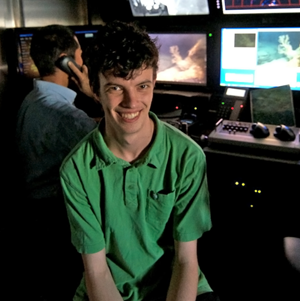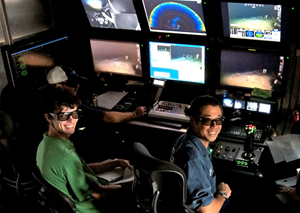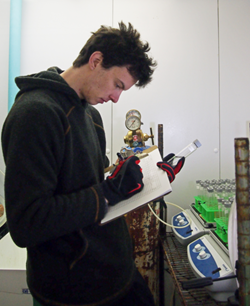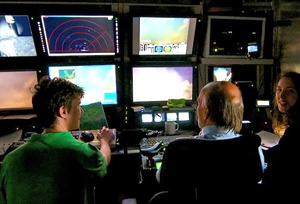
Richard Dannenberg on the R/V Falcor during an ROV dive to study Gulf coral beds. (Image credit: Schmidt Ocean Institute)
Deep below the surface of the Gulf of Mexico live vast canyons of coral. Recent news reports suggest that the Deepwater Horizon oil spill may have impacted the health of these corals.
To find out, Richard Dannenberg is delving into their world, looking at the bacteria that live with the coral for clues about that potential damage. He explains, “If we can get a sense of which bacteria are important and what their roles in the ecosystem are, we can use this to assess some effects of oil spills that might not be apparent from visual inspection of the corals.”
Rich is a GoMRI scholar with ECOGIG, working towards his Ph.D. in biology at Pennsylvania State University (PSU). He talks about the road that led him to the bottom of the Gulf and where he hopes it will lead.
His Path
Rich became interested in the deep sea during an undergraduate bioorganic chemistry course. The combination of a group assignment examining the life forms around hydrothermal vents pouring hot, mineral-rich fluids from beneath the seafloor and an in-class viewing of The Blue Planet—a mini-series detailing our oceans’ natural history—changed his life. “I was instantly hooked,” he recalls. “I knew that I could happily study the deep sea for the rest of my life.”

ROV pilot Toshi Mikagawa (center), and Samantha Berlet (right) wear 3D glasses to view live footage of coral beds deep beneath the Gulf. (Photo provided by Rich Dannenberg)
At first, his desires were no more specific than deep-sea research. But while touring graduate programs, he visited Dr. Chuck Fisher, a biologist at PSU and a co-Principal Investigator studying corals as part of the ECOGIG’s oil spill research project. Rich talked with the Fisher lab team about their work and found himself intrigued by how deep-sea corals managed to get enough energy without the sun-dependent algae that shallow-water corals use. Although he considered other graduate programs, he could not get the possibility of conducting coral research out of his mind.
Rich became involved with ECOGIG in his first year of his doctoral program at PSU, joining an expedition to look at long-term effects of the oil spill. He was the only graduate student chosen to help Fisher collect underwater imagery of deep-water coral beds on that mission. Rich describes this introduction to field research as “a great learning experience and a lot of work, but a lot of fun too.”
His Work

Rich records data about the phenotypes of black corals collected in the Gulf. (Photo provided by Rich Dannenberg)
It’s easy to tell if corals are dead, Rich said, but hard to know when they’re sick or damaged other than finding dead polyps on them. The goal is to better understand the health of the broader environment by examining changes in the surrounding bacterial community. Doing so could uncover valuable ways to assess coral damage in its earliest stages, which could possibly lead to a reversal of the process. But that is no easy task either as Rich explains, “We currently know next-to-nothing about the functions of bacterial communities in deep-sea corals.”
To bridge that knowledge gap, Rich is conducting both field and lab studies on two groups of corals. For one group, the Paramuricea coral, he does not collect samples. Instead he leaves those corals on the seafloor, and each year, Rich and his team return to photograph and monitor their condition, being careful to not touch them. He collected four colonies of the other coral group, Leiopathes, from the Mississippi Canyon and Atwater Valley in the Gulf and brought them back to the lab for live study.
After acclimating the coral to the lab environment, he cut them into smaller fragments and put each fragment in a tube with different concentrations of either oil, dispersant, both, or neither to see how the coral responded to contaminants. Rich then analyzed the bacteria on the coral, detailing each bacterium’s entire genetic information to identify differences at the gene-level. This process shows how the bacterial community reacts to the different treatments, giving insight about impacts to the corals’ health. “If I see a consistent group of bacteria present within all samples from this species,” he explains, “I can start to look at other species and other locations to see how specific the coral-bacterial associations are.”
His Learning

Penn State students Richard Dannenberg and Samantha Berlet work on either side of ROV pilot Jamie Sherwood during an ROV dive aboard the R/V Falcor. (Image credit: Debbie Nail Meyer)
Rich has been most impressed with the ECOGIG scientists’ profound sense of community, especially among the small group of deep-sea researchers. His first expedition was especially eye-opening in that regard. “Collaboration is everywhere, especially on cruises,” he said, “there is absolutely no way any individual researcher would get their work done without at least some help from those around them.” On board, he had the opportunity to assist world famous researchers with their work, but there was the flip side of that as well, “Having a ship full of researchers meant that whenever I needed help with something, I could reliably count on that help magically appearing.”
That spirit of collaboration went beyond field work, as Rich explained, “At virtually every scientific gathering, I’ve been surprised by how many good ideas come from just talking about my work to other scientists. And that sounds pretty obvious, since that’s why these scientific gatherings happen in the first place, but to me the degree to which interacting with others can foster a positive change in my thinking and research was always surprising.”
Rich has also learned the importance of doing work you love, “If you try to force an interest in something you’ll end up losing motivation very quickly, but passion can carry you through almost anything, giving you the willpower to work harder than you ever thought you could.”
His Future
Rich is on the fence about where he will wind up after completing his Ph.D. While he enjoys academia’s balance of research and teaching, he is also interested in a government position or working in industry. Until he decides, his focus remains on data collection and on his upcoming wedding.
Praise for Richard
Rich’s advisors, Chuck Fisher and Iliana Baums of PSU, expressed confidence that his research will play an important role in helping scientists understand how deep-water corals respond to stress. “His project is quite ambitious,” Baums said and noted the large scale of Rich’s study, “starting with a description of the yet uncharacterized microbiome of deep sea corals and then investigating how this population of microbes changes in response to oil and dispersant exposure.” Fisher and Baums explained that while this topic has received little attention in the past, it has become increasingly clear that single-celled organisms living near the coral play an important role in determining the health and resilience of the entire community.
Fisher added that much of the project’s success is due to Rich’s adaptability. “Rich has overcome a number of unexpected and rather major challenges while developing his methods and is now generating very interesting data on this cutting-edge subject.”
The GoMRI community embraces bright and dedicated students like Richard Dannenberg and their important contributions. The GoMRI Scholars Program recognizes graduate students whose work focuses on GoMRI-funded projects and builds community for the next generation of ocean science professionals.
Visit the ECOGIG website to learn more about their work.
************
This research was made possible in part by a grant from BP/The Gulf of Mexico Research Initiative (GoMRI) to theEcosystem Impacts of Oil and Gas Inputs to the Gulf (ECOGIG) consortium.
The GoMRI is a 10-year independent research program established to study the effect, and the potential associated impact, of hydrocarbon releases on the environment and public health, as well as to develop improved spill mitigation, oil detection, characterization and remediation technologies. An independent and academic 20-member Research Board makes the funding and research direction decisions to ensure the intellectual quality, effectiveness and academic independence of the GoMRI research. All research data, findings and publications will be made publicly available. The program was established through a $500 million financial commitment from BP. For more information, visit http://gulfresearchinitiative.org/.
